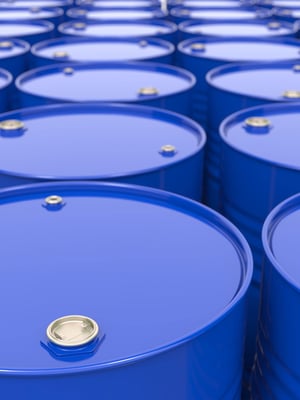If your business generates hazardous waste, you know the importance of managing and storing these waste streams correctly.
It’s important that the job is done correctly AND in accordance with all hazardous waste laws. During hazardous waste inspections, which can happen at any time, inspectors from the California Department of Toxic Substances Control will look at how you store your hazardous waste.
Your hazardous waste storage is an important component of your compliance with federal and state laws. Let’s take a look at a few things you need to know about hazardous waste storage to keep you out of hot water with inspectors.
Proper Containers
 The containers themselves play a critical role in your company’s compliance with hazardous waste storage laws. All hazardous waste generators must ensure their containers are built to specifications according to the most current codes and regulations.
The containers themselves play a critical role in your company’s compliance with hazardous waste storage laws. All hazardous waste generators must ensure their containers are built to specifications according to the most current codes and regulations.
It’s important to note that hazardous waste containers aren’t always what comes to mind initially. Although the most common hazardous waste container is a 55-gallon drum, other examples include tanker trucks, buckets, railroad cars and even test tubes.
The following is a list of some of the other types of hazardous waste storage containers, according to the Environmental Protection Agency:
- Containers: Portable devices in which hazardous waste is stored, transported, etc., otherwise handled.
- Tanks: Stationary device of man-made materials used to store hazardous waste, either open or closed.
- Drop pads: Wood drying structure used by pressure treated wood industry to collect excess wood preservatives and drippings.
- Containment buildings: Completely enclosed self-supporting structures used to store or treat non-containerized hazardous waste.
- Waste piles: Open, uncovered piles used for treating or storing hazardous waste.
- Surface impoundments: A natural topographical depression, man-made excavation or diked area, such as a holding pond, storage pit or settling lagoon.
So how do you select the correct container for your hazardous waste? Our article, How To Choose The Right Hazardous Waste Storage Container shares additional information you should be aware of when choosing storage containers.
Container Maintenance
Just because you have the right container doesn’t mean compliance stops there. There are certain aspects of your storage inspectors will examine as well. According to the Resource Conservation and Recovery Act (RCRA), these include:
- Condition of container: Make sure your containers are not deteriorating in any way, such as through cracking, rusting or leaking.
- Incompatible wastes: Containers must be made of or lined with a material that does not react to the waste stored inside the container. In general, incompatible wastes and materials shouldn’t be placed in the same container. Doing so may lead to dangerous chemical reactions that can cause explosions or deadly fumes.
- Air emissions: Your containers may be required to follow air emissions standards as well, depending on the waste you are storing.
Often, the condition of the container is just as important as what type of waste you are storing inside.
Waste Labels
Getting a label from your local office store doesn’t cut it when we’re talking about hazardous waste. Hazardous waste generators that accumulate and store waste onsite must follow RCRA regulations that include proper labeling, marking and placarding.
The California Department of Toxic Substances Control (DTSC) also enforces its own set of labeling requirements for California hazardous waste generators. For example, hazardous waste labels must include:
- The composition and physical state of the waste
- A statement that calls attention to the hazardous properties of the waste
- Name and address of the generator
Once you’ve placed any hazardous waste into a container, you must properly mark and label that container. More information about rules and regulations you should be aware of can be found in our article, How To Properly Label Hazardous Waste Containers.
If you are transporting this waste off your property, it’s important to be aware of any additional Hazardous Waste Label Requirements You Should Know.
Amount Of Waste
 In addition to selecting the right storage containers and labeling them correctly for your waste streams, it’s important to understand other aspects about have hazardous waste containers on your property as well.
In addition to selecting the right storage containers and labeling them correctly for your waste streams, it’s important to understand other aspects about have hazardous waste containers on your property as well.
This includes how long waste can be stored or how frequently you must inspect your storage areas. To do this, you must understand your hazardous waste generator requirements.
One of the largest factors is the amount of waste you generate. The EPA divides waste generators into three main classifications based upon the quantity of hazardous waste that is produced.
- Very Small Quantity Generators generate 100 kilograms or less per month of hazardous waste or 1 kilogram or less per month of acutely hazardous waste.
- Small Quantity Generators generate more than 100 kilograms, but less than 1,000 kilograms of hazardous waste per month.
- Large Quantity Generators generate 1,000 kilograms per month or more of hazardous waste, or more than 1 kilogram per month of acutely hazardous waste.
Once you understand which category you fall into, you can better assess the specific requirements you must meet. For example, Small Quantity Generators may accumulate hazardous waste onsite for 180 days without a permit, or for 270 days if shipping more than 200 miles away. Large Quantity Generators, however, may only accumulate waste onsite for 90 days, though certain exceptions apply.
Understanding the regulations you must follow also allows you to put into place procedures that allow you to proactively monitor your operation and spot any issues in advance.
Common Violations
When it comes to using hazardous waste containers, there are two common storage issues businesses face that often lead to fines.
Open containers: It seems like a no-brainer, but many companies violate the law that containers of hazardous waste must be closed. They also must always be latched, except when adding or removing waste.
Infrequent or lack of inspections: Hazardous waste generators are required to perform a weekly inspection of the hazardous waste container storage areas. This is very easy to implement in your company’s standard procedures in order to maintain compliance.
The Right Partner
The task of managing your hazardous waste streams is a full-time job. Staying current on regulations, ensuring that your protocols comply, and making sure your employees are properly trained are all part of the process.
Most companies find value in hiring an experienced and properly licensed hazardous waste disposal company. Liability is always an issue in any business, and especially in the business of hazardous waste. That’s why hiring a certified hazardous waste company to manage the needs of your company makes sense on many levels.


Comment